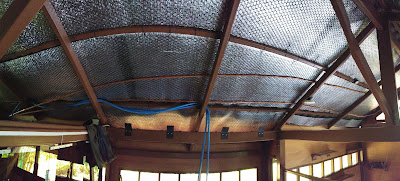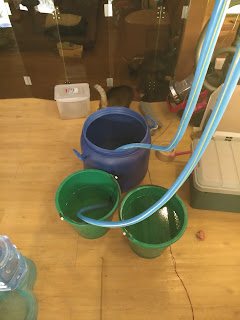Since the weather in Thailand is very hot, the roof temperature of Ban Rim Nam can get up to about 50C (inside!). (This is inside of the 1 cm insulation.) At the same time, under the house is about 29C. So we thoughht about cooling the roof to decrease the temperature inside. In this experiment we found the coefficient of productivity (COP) of the cooling system by pumping fairly cool water through 15m of 0.75 inch copper pipe that was attached under the roof. We use a blue bucket for supply the water, and green buckets for output water.
For this test, the roof temperature varied from 46.7 – 44.7C over the 1 hour. Ambient temperature and input water temperature are 42 and 31.9 Celsius respectively. We tested 5 times with 4 water flow rates.
- Flow rate : 7.27 l/min ===> Water output temperature increase 0.4 Celsius.
- Flow rate : 3.07 l/min ===> Water output temperature increase 1.7 Celsius.
- Flow rate : 5.50 l/min ===> Water output temperature increase 1.6 Celsius.
- Flow rate : 0.30 l/min ===> Water output temperature increase 1.6 Celsius.
- Flow rate : 7.27 l/min ===> Water output temperature increase 0.7 Celsius.
For the test at flow rates under 3.07 l/min, water output temperature did not increase. (Something to do with how the water flows in the pipe?) From this result, if we choose the 5.50 l/min flow rate to calculate cooling power in heat transfer formula.
Q = mc𝛥t = (5.5/60)*4186*(1.6) = 614 W of cooling.
We adjust the pump voltage to 10 V. to supply water at 5.50 l/min flow rate, current on the supply is just 0.25 A. So we supply 2.5 W power to gain 614 W of cooling. The COP of this experiment is 245.6 which is about 80 times a normal air conditioner COP. If we add more copper pipe and circulate the water to under the house which is colder than this experiment about 13 Celsius, cooling power and COP should more than experiment result.


